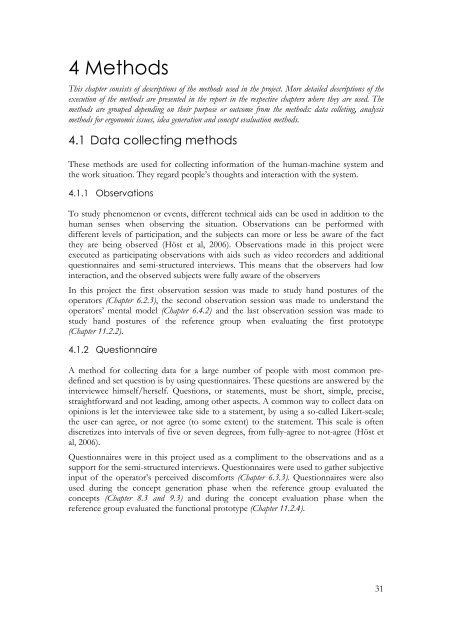Design of an ergonomic control lever for wheel loader attachments
Design of an ergonomic control lever for wheel loader attachments
Design of an ergonomic control lever for wheel loader attachments
You also want an ePaper? Increase the reach of your titles
YUMPU automatically turns print PDFs into web optimized ePapers that Google loves.
4 Methods<br />
This chapter consists <strong>of</strong> descriptions <strong>of</strong> the methods used in the project. More detailed descriptions <strong>of</strong> the<br />
execution <strong>of</strong> the methods are presented in the report in the respective chapters where they are used. The<br />
methods are grouped depending on their purpose or outcome from the methods: data colleting, <strong>an</strong>alysis<br />
methods <strong>for</strong> <strong>ergonomic</strong> issues, idea generation <strong>an</strong>d concept evaluation methods.<br />
4.1 Data collecting methods<br />
These methods are used <strong>for</strong> collecting in<strong>for</strong>mation <strong>of</strong> the hum<strong>an</strong>-machine system <strong>an</strong>d<br />
the work situation. They regard people’s thoughts <strong>an</strong>d interaction with the system.<br />
4.1.1 Observations<br />
To study phenomenon or events, different technical aids c<strong>an</strong> be used in addition to the<br />
hum<strong>an</strong> senses when observing the situation. Observations c<strong>an</strong> be per<strong>for</strong>med with<br />
different levels <strong>of</strong> participation, <strong>an</strong>d the subjects c<strong>an</strong> more or less be aware <strong>of</strong> the fact<br />
they are being observed (Höst et al, 2006). Observations made in this project were<br />
executed as participating observations with aids such as video recorders <strong>an</strong>d additional<br />
questionnaires <strong>an</strong>d semi-structured interviews. This me<strong>an</strong>s that the observers had low<br />
interaction, <strong>an</strong>d the observed subjects were fully aware <strong>of</strong> the observers<br />
In this project the first observation session was made to study h<strong>an</strong>d postures <strong>of</strong> the<br />
operators (Chapter 6.2.3), the second observation session was made to underst<strong>an</strong>d the<br />
operators’ mental model (Chapter 6.4.2) <strong>an</strong>d the last observation session was made to<br />
study h<strong>an</strong>d postures <strong>of</strong> the reference group when evaluating the first prototype<br />
(Chapter 11.2.2).<br />
4.1.2 Questionnaire<br />
A method <strong>for</strong> collecting data <strong>for</strong> a large number <strong>of</strong> people with most common predefined<br />
<strong>an</strong>d set question is by using questionnaires. These questions are <strong>an</strong>swered by the<br />
interviewee himself/herself. Questions, or statements, must be short, simple, precise,<br />
straight<strong>for</strong>ward <strong>an</strong>d not leading, among other aspects. A common way to collect data on<br />
opinions is let the interviewee take side to a statement, by using a so-called Likert-scale;<br />
the user c<strong>an</strong> agree, or not agree (to some extent) to the statement. This scale is <strong>of</strong>ten<br />
discretizes into intervals <strong>of</strong> five or seven degrees, from fully-agree to not-agree (Höst et<br />
al, 2006).<br />
Questionnaires were in this project used as a compliment to the observations <strong>an</strong>d as a<br />
support <strong>for</strong> the semi-structured interviews. Questionnaires were used to gather subjective<br />
input <strong>of</strong> the operator’s perceived discom<strong>for</strong>ts (Chapter 6.3.3). Questionnaires were also<br />
used during the concept generation phase when the reference group evaluated the<br />
concepts (Chapter 8.3 <strong>an</strong>d 9.3) <strong>an</strong>d during the concept evaluation phase when the<br />
reference group evaluated the functional prototype (Chapter 11.2.4).<br />
31
















